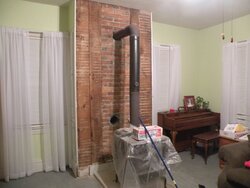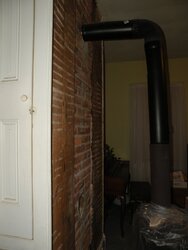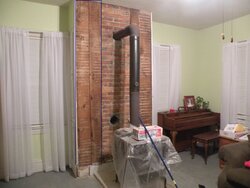Here's what I know; I need 18" from my single wall stove pipe to combustibles.
I have 18+ to the ceiling, and more than 20" to the rear wall (which is the brick chimney anyway).
Where the stove passes through the chimney into my liner is where the problem lies (I think). I only have 9" to the side of some cabinets that were built into the side of the chimney (see pic 1). Now, the wood is flush with the chimney (see pic 2), but I think that doesn't matter. Correct me if I'm wrong on that.
So, if indeed I am violating that clearance requirement, help me come up with some fast, creative, yet attractive solutions. My first thought was to replace the side board of the cabinet with Durock for starters. Would that put me in good standing with the clearance requirements?
A note; we haven't decided what the final product should look like. It probably involves me building the entire wall up with brick and making a brick hearth to go with it, but that's not happening for a few years. This 175 year old place has some more pressing issues to deal with before that.
The stove, being shy in these pics, is a Regency F2400. I'm waiting on some parts from the dealer (baffle bricks and two new air tubes) so I'm trying to get the install sorted in the meantime.
Edit: according to https://www.hearth.com/econtent/index.php/articles/passing_a_chimney
I only need 12" of solid masonry surrounding this? I still do not have it, though.


I have 18+ to the ceiling, and more than 20" to the rear wall (which is the brick chimney anyway).
Where the stove passes through the chimney into my liner is where the problem lies (I think). I only have 9" to the side of some cabinets that were built into the side of the chimney (see pic 1). Now, the wood is flush with the chimney (see pic 2), but I think that doesn't matter. Correct me if I'm wrong on that.
So, if indeed I am violating that clearance requirement, help me come up with some fast, creative, yet attractive solutions. My first thought was to replace the side board of the cabinet with Durock for starters. Would that put me in good standing with the clearance requirements?
A note; we haven't decided what the final product should look like. It probably involves me building the entire wall up with brick and making a brick hearth to go with it, but that's not happening for a few years. This 175 year old place has some more pressing issues to deal with before that.
The stove, being shy in these pics, is a Regency F2400. I'm waiting on some parts from the dealer (baffle bricks and two new air tubes) so I'm trying to get the install sorted in the meantime.
Edit: according to https://www.hearth.com/econtent/index.php/articles/passing_a_chimney
I only need 12" of solid masonry surrounding this? I still do not have it, though.


Last edited by a moderator:



